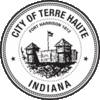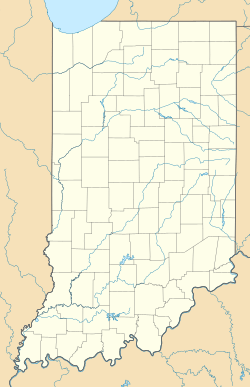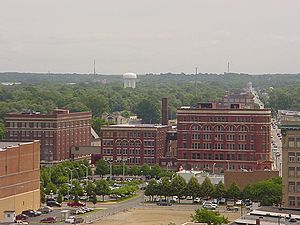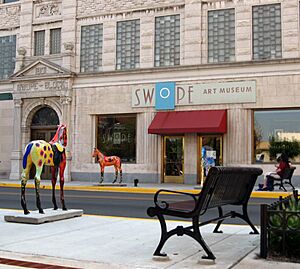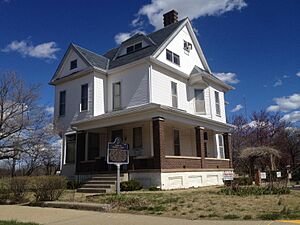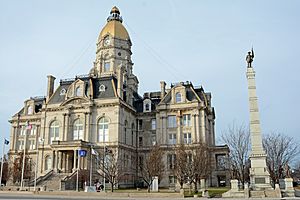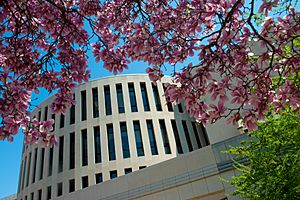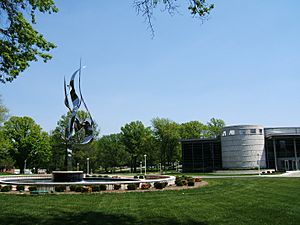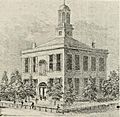Terre Haute, Indiana facts for kids
Quick facts for kids
Terre Haute
|
|||
|---|---|---|---|
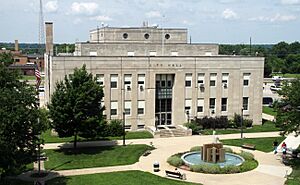
Terre Haute City Hall in 2012
|
|||
|
|||
| Nickname(s): | |||
| Motto(s):
"A Level Above"
|
|||
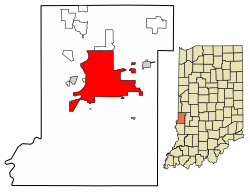
Location of Terre Haute in Vigo County, Indiana.
|
|||
| Country | |||
| State | |||
| County | Vigo | ||
| Townships | Harrison, Lost Creek, Honey Creek, Prairieton, Riley | ||
| Government | |||
| • Type | Mayor-council | ||
| • Body | Terre Haute City Council | ||
| Area | |||
| • Total | 35.16 sq mi (91.07 km2) | ||
| • Land | 34.77 sq mi (90.06 km2) | ||
| • Water | 0.39 sq mi (1.01 km2) | ||
| Elevation | 499 ft (152 m) | ||
| Population
(2020)
|
|||
| • Total | 58,389 | ||
| • Density | 1,679.15/sq mi (648.33/km2) | ||
| Demonym(s) | Hautean /ˈhoʊʃɪn/ |
||
| Time zone | UTC−5 (Eastern Time Zone) | ||
| • Summer (DST) | UTC−4 (EDT) | ||
| ZIP Codes |
47801-47805, 47807-47809
|
||
| Area code(s) | 812 & 930 | ||
| FIPS code | 18-75428 | ||
| GNIS feature ID | 444648 | ||
Terre Haute (pronounced TERR-ə HOHT) is a city in Vigo County, Indiana, United States. It is the main city of Vigo County. In 2020, about 58,389 people lived in the city. Its larger metropolitan area had about 168,716 people.
Terre Haute is located along the Wabash River. It is about 5 miles (8 km) east of the border with Illinois. The city is one of the biggest in the Wabash Valley. It is often called the "Queen City of the Wabash." Terre Haute is home to several colleges. These include Indiana State University, Rose-Hulman Institute of Technology, and Ivy Tech Community College of Indiana. It also has the United States Penitentiary, Terre Haute.
Contents
History of Terre Haute
Terre Haute gets its name from a French phrase. Terre haute (pronounced tair oat in French) means "highland." French-Canadian explorers and fur traders gave it this name in the early 1700s. They used it to describe the high land above the Wabash River. At that time, this area was a border between French and British lands.
Early Settlements and Growth

The building of Fort Harrison in 1811 was the start of European-American settlement. A Wea Indian village was already near the fort. Their orchards and meadows became the site of today's city. The village of Terre Haute was planned in 1816. It was then part of Knox County, Indiana.
Terre Haute became the main city of the new Vigo County in 1818. This helped its population grow. In 1832, the village's 1,000 residents voted to become an official town. It became a city in 1853.
Transportation and Industry
Early Terre Haute was a center for farming and food processing. But the city's growth before 1960 was mostly due to transportation. The Wabash River, the National Road (US 40), and the Wabash and Erie Canal connected Terre Haute to other places.
The economy grew with iron and steel mills. Distilleries, breweries, and bottle makers also became important later in the 1800s. Coal mines supported the railroads. Farming remained a big part of the economy.
City Life and Entertainment
In the late 1800s, the city grew steadily. It gained better fire protection and two hospitals. Many churches were built. Terre Haute also became a center for education. Several colleges were started.
The city became known for its arts and entertainment. Grand opera houses hosted many shows. It was a popular stop for vaudeville acts. Electric trolleys in the 1890s made it easy for people to travel. They could go to baseball games, picnics, and amusement parks. The famous "Four-Cornered" Racetrack, built in 1886, attracted top horse racers. Today, Memorial Stadium is on this site.
Challenges and Recovery
On Easter Sunday, March 23, 1913, a large tornado hit the city. It destroyed over 300 homes. 21 people died and 250 were hurt. Businesses and industries faced millions of dollars in damage. This was the deadliest tornado in Indiana at that time. Heavy rains followed, causing the Wabash River to flood. West Terre Haute (Taylorville) was mostly underwater.
Like other U.S. cities, Terre Haute faced economic ups and downs. Before the Great Depression, industries like distilleries and railroad repair struggled. In 1940, a new United States penitentiary was built south of the city.
World War II brought an economic boost. Three ordnance plants were built in the county. Coal, railroad, and farming industries became busy again. Terre Haute was very involved in the war effort. It had troop send-offs, victory gardens, and parades. A United Service Organizations (USO) center opened in the city in 1943.
After the war, new factories came to Terre Haute. These included Pfizer (1948) and Columbia Records (1954). The downtown area began to change in the late 1960s. Interstate 70 was built, passing south of the city. Many downtown businesses moved to the Honey Creek Mall shopping center, which opened in 1968.
Modern Growth and Revitalization
Local groups worked to improve the economy. The Fort Harrison Industrial Park was developed in the 1970s. In the mid-1980s, "Grow Terre Haute" helped bring new stores and factories. This included Sony's Digital Audio Disc Corporation (DADC), the first U.S. factory to make compact discs.
Like other manufacturing cities, Terre Haute faced challenges in the late 1900s. People moved away, and some factories closed. However, the city's economy is diverse. Manufacturing is still important due to the Vigo County Industrial Park. This park is home to major companies like Companhia Siderúrgica Nacional (steel), Staples Corporation (distribution), and Advics (automotive brakes).
The downtown area has been revitalized. This started with First Financial Bank's new headquarters in the late 1980s. Many new office buildings and parking structures followed.
Nonprofit groups and Indiana State University have helped downtown grow. New hotels and businesses have opened near "Crossroads of America" (7th and Wabash). Outdoor events and festivals happen almost every summer weekend. The 7th Street Arts Corridor and the Terre Haute Children's Museum, finished in 2010, make downtown more appealing. These changes have encouraged property owners to fix up their buildings. A new $25 million downtown convention center was completed in 2021.
Indiana State University has also strengthened its ties with the city. Its Scott College of Business moved into the renovated Federal Building in 2010. In 2015, the university partnered to build student housing downtown. Other downtown housing projects have followed.
A casino opened on the east side of the city in March 2024. Voters approved the idea in November 2019.
Geography and Climate
Terre Haute is on the eastern bank of the Wabash River. It is in western Indiana, about 75 miles (121 km) west of Indianapolis.
In 2010, Terre Haute covered about 35.27 square miles (91.35 km2). About 2.08% of this area is water.
The Wabash River forms the city's western border. Small hills on the east side mark the edge of the old flood plain. Lost Creek and Honey Creek flow through the northern and southern parts of the city. In the late 1800s, oil and mineral wells were found in the city. In 2013, oil drilling started again on the Indiana State University campus. This was the first oil well drilled downtown since 1903.
Terre Haute is at the crossing of two major roads. These are U.S. 40 (from California to Maryland) and US 41 (from Michigan to Florida). US 41 is now called 3rd Street locally. But it was historically 7th Street, making "7th and Wabash" the "Crossroads of America." Terre Haute is 77 miles (124 km) southwest of Indianapolis. It is also within 185 miles (298 km) of Chicago, St. Louis, Louisville, and Cincinnati.
Climate in Terre Haute
Terre Haute has warm summers and winters that are near freezing. Rain is spread out evenly throughout the year. This type of weather is called a humid subtropical climate.
| Climate data for Terre Haute, IN (Terre Haute Regional Airport) 1991-2020 normals, extremes 1896–present | |||||||||||||
|---|---|---|---|---|---|---|---|---|---|---|---|---|---|
| Month | Jan | Feb | Mar | Apr | May | Jun | Jul | Aug | Sep | Oct | Nov | Dec | Year |
| Record high °F (°C) | 69 (21) |
76 (24) |
86 (30) |
89 (32) |
99 (37) |
108 (42) |
109 (43) |
102 (39) |
104 (40) |
94 (34) |
82 (28) |
74 (23) |
109 (43) |
| Mean daily maximum °F (°C) | 36.7 (2.6) |
41.6 (5.3) |
52.8 (11.6) |
64.9 (18.3) |
74.6 (23.7) |
83.3 (28.5) |
85.9 (29.9) |
84.6 (29.2) |
79.0 (26.1) |
66.7 (19.3) |
52.6 (11.4) |
41.1 (5.1) |
63.7 (17.6) |
| Daily mean °F (°C) | 28.7 (−1.8) |
32.9 (0.5) |
42.8 (6.0) |
53.9 (12.2) |
64.0 (17.8) |
72.7 (22.6) |
75.3 (24.1) |
73.6 (23.1) |
66.6 (19.2) |
54.9 (12.7) |
43.1 (6.2) |
33.5 (0.8) |
53.5 (11.9) |
| Mean daily minimum °F (°C) | 20.7 (−6.3) |
24.1 (−4.4) |
32.8 (0.4) |
42.9 (6.1) |
53.4 (11.9) |
62.2 (16.8) |
64.8 (18.2) |
62.5 (16.9) |
54.2 (12.3) |
43.0 (6.1) |
33.7 (0.9) |
25.9 (−3.4) |
43.4 (6.3) |
| Record low °F (°C) | −18 (−28) |
−20 (−29) |
−6 (−21) |
19 (−7) |
29 (−2) |
37 (3) |
43 (6) |
43 (6) |
30 (−1) |
18 (−8) |
−4 (−20) |
−16 (−27) |
−20 (−29) |
| Average precipitation inches (mm) | 2.60 (66) |
2.02 (51) |
2.92 (74) |
4.71 (120) |
4.71 (120) |
4.64 (118) |
4.34 (110) |
2.99 (76) |
2.93 (74) |
3.44 (87) |
3.05 (77) |
2.49 (63) |
40.84 (1,037) |
| Average precipitation days (≥ 0.01 in) | 8.9 | 9.0 | 10.6 | 11.4 | 13.1 | 11.7 | 11.2 | 9.5 | 8.8 | 9.4 | 8.9 | 10.1 | 122.6 |
| Source: NOAA | |||||||||||||
Population and People
| Historical population | |||
|---|---|---|---|
| Census | Pop. | %± | |
| 1850 | 4,051 | — | |
| 1860 | 8,594 | 112.1% | |
| 1870 | 16,103 | 87.4% | |
| 1880 | 26,042 | 61.7% | |
| 1890 | 30,217 | 16.0% | |
| 1900 | 36,673 | 21.4% | |
| 1910 | 58,157 | 58.6% | |
| 1920 | 66,083 | 13.6% | |
| 1930 | 62,810 | −5.0% | |
| 1940 | 62,693 | −0.2% | |
| 1950 | 64,214 | 2.4% | |
| 1960 | 71,786 | 11.8% | |
| 1970 | 70,335 | −2.0% | |
| 1980 | 61,125 | −13.1% | |
| 1990 | 57,483 | −6.0% | |
| 2000 | 59,614 | 3.7% | |
| 2010 | 60,785 | 2.0% | |
| 2020 | 58,389 | −3.9% | |
| U.S. Decennial Census | |||
2020 Census Information
In 2020, Terre Haute had 58,389 people living in 22,977 households. The city's population density was about 1,679 people per square mile (648 per km2). Most residents (78.9%) were white. About 10.8% were African American, and 4.2% were Native American. People of Hispanic or Latino background made up 3.9% of the population.
About 26.3% of households had children under 18. The average household size was 2.24 people. The average family size was 2.96 people. The median age in the city was 32.5 years. About 19.1% of residents were under 18.
Economy and Jobs
Major Employers in Terre Haute
Many different companies and organizations provide jobs in Terre Haute. Here are some of the biggest employers:
- Advics (automotive parts)
- Amcor (packaging)
- Casey's General Stores
- City of Terre Haute
- United States Federal Correctional Complex
- First Financial Bank
- GE Aviation (aircraft parts)
- Indiana State University
- Ivy Tech Community College
- Rose-Hulman Institute of Technology
- Sony Digital Audio Disc Corporation (Sony DADC)
- Taghleef Industries, Inc (packaging)
- Terre Haute Regional Hospital
- Union Associated Physicians
- Union Hospital
- Vigo County School Corporation
- Vigo County
- Wabash Valley Correctional Facility
Federal Correctional Complex
Terre Haute is home to the Federal Correctional Complex, Terre Haute. This complex includes a medium-security prison and a high-security prison.
Arts and Culture
Terre Haute has worked hard to improve its downtown area. Festivals, museums, restaurants, and new hotels have made downtown more appealing. In 2010, the Indiana Chamber of Commerce named Terre Haute Indiana's Community of the Year.
Art and Galleries
The Terre Haute Arts Corridor is on 7th Street. It includes the Swope Art Museum and two art galleries. On the first Friday of each month, the area hosts art shows and music.
The Swope Art Museum has been open and free since 1942. It has a collection of American art. This includes works by famous artists like Edward Hopper and Andy Warhol.
Indiana State University's Turman Art Gallery shows art by students and teachers. In 2007, the university received nearly 150 Andy Warhol photographs and prints. The gallery's permanent collection has 3,600 pieces of art.
The historic Indiana Theater is a key part of the Arts Corridor. It was designed in a Spanish style and opened in 1922. The theater has been restored and now hosts concerts and movies.
Terre Haute also has several art groups. These include Wabash Valley Art Spaces and Arts Illiana.
Live Performances
The Community Theatre of Terre Haute started in 1928. It is a volunteer theater that puts on five plays and musicals each year.
Terre Haute also has the Crossroads Repertory Theatre. This is a professional theater company with over 40 years of history. They perform classic and new plays and musicals from mid-June to late-July.
Hatfield Hall is a 602-seat theater at Rose-Hulman Institute of Technology. It hosts a performing arts series every year. Indiana State University also has a performing arts series. These shows include Broadway musicals, music acts, plays, and dance performances.
Music Scene
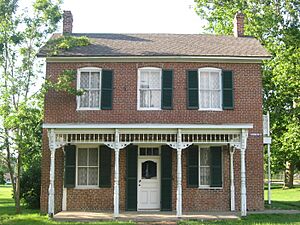
Terre Haute has many music venues and a strong music community. The Wabash Valley Musicians Hall of Fame honors local musicians each year.
The Blues at the Crossroads Festival brings over 15,000 blues fans to the city every September. Indiana State University hosts a high-school jazz festival each year. Terre Haute is also the birthplace of musician and actor Scatman Crothers.
The Terre Haute Symphony Orchestra started in 1926. It is the oldest professional orchestra in Indiana. The orchestra performs concerts from September to April. It also offers a free concert for about 3,000 fourth graders.
Other music groups in Terre Haute include the Terre Haute Community Band and the Terre Haute Children's Choir.
Paul Dresser, a singer and songwriter, was born in Terre Haute. He was famous in the late 1800s. In 1913, his song "On the Banks of the Wabash, Far Away" became Indiana's state song. His birthplace in Fairbanks Park is a museum. A bronze sculpture honoring him was placed near his home in 2014.
Museums to Explore
The Vigo County Historical Society Museum has many old items. It is in a large, four-level building built in 1895. The Terre Haute Children's Museum and the Clabber Girl Museum are also nearby.
The Terre Haute Children's Museum is a three-story building downtown. It is a hands-on science and technology museum. It has taught over 230,000 adults and children. The museum also has traveling exhibits about weather and space.
The Clabber Girl Museum is in the Hulman & Company building, built in 1892. It shows the history of Clabber Girl, a very old American brand. It also teaches about baking. The museum is next to the factory where Clabber Girl Baking Powder is still made.
The Kleptz Antique Auto Museum displays old cars and motorcycles. It has unique vehicles like a 1902 clear plastic car.
The CANDLES Holocaust Museum and Education Center was created by Holocaust survivor Eva Mozes Kor. It has exhibits about the Holocaust and forgiveness.
The Indiana Association of Track and Field and Cross-Country Museum is a new addition to the city.
Terre Haute was the home of Eugene V. Debs. He was a leader of the Socialist Party of America. His former home is now a museum at Indiana State University. It is a National Historic Landmark. The museum shows many of Debs' belongings.
Sports and Recreation
Terre Haute Rex Baseball
The Terre Haute Rex is a summer baseball team for college players. It started in 2010. The team plays its home games at Bob Warn Field at ISU's Sycamore Stadium. Their season runs from late May to early August. The team is named after Rex Coffee, a product once made in downtown Terre Haute.
Terre Haute has a long history of professional baseball. Many famous players have played here. These include Hall-of-Famers Mordecai Brown and Max Carey. Other stars like Tommy John and Brian Dorsett also played here.
Parks and Outdoor Fun
Terre Haute has been named a Tree City USA since 1999. This means it does a great job managing its urban forests. Indiana State University is also a Tree Campus.
The Terre Haute Parks Department manages over 1,000 acres (405 ha) of land. This includes parks, trails, and two golf courses.
Some popular parks are:
- Deming Park - This is the largest park, with 177 acres (72 ha). It has a playground, a disc golf course, a public pool, a miniature train, and sports courts.
- Dobbs Park - This park has a nature center and a Native American museum. It also features a pond, a restored prairie, a butterfly garden, and 3 miles (4.8 km) of trails.
- National Road Heritage Trail - This is a paved trail about 6.5 miles (10.5 km) long. It is great for running, walking, biking, and rollerblading.
Cross-Country Course
The LaVern Gibson Championship Cross Country Course is one of the few courses built just for cross-country running. It is part of the Wabash Valley Family Sports Center. The course is built on an old coal mine. It has different loops for various race lengths. Indiana State University's cross-country team uses this course. It has also hosted national championship meets.
City Government
Brandon Sakbun became Terre Haute's mayor in January 2024. He won the election in 2023. He is the youngest mayor in the city's history, starting at age 27.
The city council has nine members. Six members represent different areas of the city. Three members represent the city as a whole.
Education in Terre Haute
The Vigo County School Corporation serves Terre Haute. It manages 18 elementary schools, five middle schools, and three high schools. About 14,642 students attend these schools.
Terre Haute also has several colleges:
- Indiana State University (ISU) is in downtown Terre Haute. In August 2024, it had 7,895 students. The Princeton Review has named ISU one of the "Best in the Midwest" colleges for nine years in a row.
- Rose-Hulman Institute of Technology is a private engineering school east of the city. It has about 2,200 students. U.S. News & World Report has ranked it the number-one undergraduate engineering school for 20 years.
- Ivy Tech Community College has a campus in Terre Haute. It is part of a statewide system.
The city also has a public library, the Vigo County Public Library.
Media and News
Newspapers and Magazines
- Tribune Star (newspaper)
- Terre Haute Living (magazine)
- Wabash Valley Business Monthly (magazine)
Television Channels
- WTWO - Channel 2.1 (NBC)
- WTHI - Channel 10.1 (CBS)
- WAWV - Channel 38.1 (ABC)
Radio Stations
Terre Haute has many radio stations playing different types of music and news. Some examples include:
- WISU - 89.7 FM (NPR)
- WZIS - 90.7 FM (Variety)
- WTHI - 99.9 FM (Country)
- WMGI - 100.7 FM (Top 40/Pop)
City Services
Transportation Options
Airports
Two airports serve Terre Haute. The Terre Haute Regional Airport (HUF) works with military units. It also has a flight academy through ISU. Sky King Airport is mostly for training and fun flights.
Major Roads
 Interstate 70 goes to St. Louis (west) and Indianapolis (east).
Interstate 70 goes to St. Louis (west) and Indianapolis (east). US 40 goes to Effingham, Illinois (west) and Indianapolis (east).
US 40 goes to Effingham, Illinois (west) and Indianapolis (east). US 41 goes to Rockville, Indiana (north) and Evansville, Indiana (south). It is a main road on Terre Haute's west side.
US 41 goes to Rockville, Indiana (north) and Evansville, Indiana (south). It is a main road on Terre Haute's west side. US 150 enters Terre Haute from West Terre Haute, Indiana.
US 150 enters Terre Haute from West Terre Haute, Indiana. SR 46 starts west of Rose-Hulman and goes south to Bloomington.
SR 46 starts west of Rose-Hulman and goes south to Bloomington. SR 63 enters Terre Haute from the north, crossing the Wabash River.
SR 63 enters Terre Haute from the north, crossing the Wabash River. SR 641, also called the Terre Haute Bypass, is a highway that helps traffic move around the city.
SR 641, also called the Terre Haute Bypass, is a highway that helps traffic move around the city.
Bus Services
All city and intercity buses use the downtown Cherry Street Multi-Modal Transportation Facility.
- The Terre Haute Transit Utility provides bus service around the city. In 2025, the city buses will not charge a fare.
- Greyhound Lines offers bus service to other states.
- Miller Transportation Hoosier Ride provides daily bus service to Indianapolis.
Railways
Terre Haute used to be a big train hub. Many trains passed through the city, connecting it to places like St. Louis, New York City, Chicago, and New Orleans. The last passenger train stopped running in 1979.
Sister Cities
Terre Haute has two sister cities, which are cities that partner for cultural exchange:
Images for kids
-
The first Vigo County Courthouse (1818–1866)
See also
 In Spanish: Terre Haute (Indiana) para niños
In Spanish: Terre Haute (Indiana) para niños



